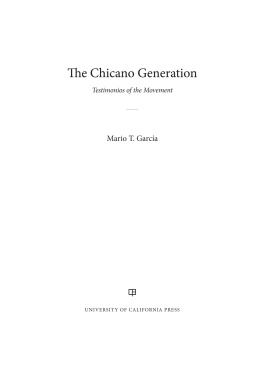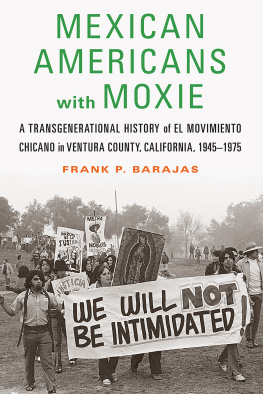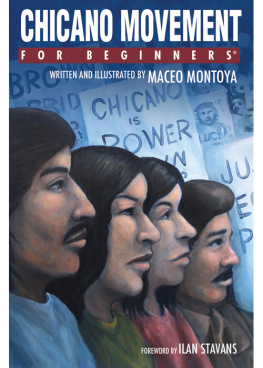Chicanas of 18th StreetLATINOS IN CHICAGO AND THE MIDWEST
Series Editors
Frances R. Aparicio,
University of Illinois at Chicago
Pedro Cabn,
State University of New York
Juan Mora-Torres,
DePaul University
Mara de los Angeles Torres,
University of Illinois at Chicago
A list of books in the series appears at the end of this book.
Chicanas of 18th Street
Narratives of a Movement from Latino Chicago
LEONARD G. RAMREZ
with
YENELLI FLORES
MARA GAMBOA
ISAURA GONZLEZ
VICTORIA PREZ
MAGDA RAMREZ-CASTAEDA
CRISTINA VITAL
UNIVERSITY OF ILLINOIS PRESS
Urbana, Chicago, and Springfield
2011 by the Board of Trustees of the University of Illinois
All rights reserved
Manufactured in the United States of America
1 2 3 4 5 C P 5 4 3 2 1

This book is printed on acid-free paper.
Library of Congress Cataloging-in-Publication Data
Chicanas of 18th Street : narratives of a movement from Latino
Chicago / Leonard G. Ramrez ; with Yenelli Flores [et al.].
p. cm.(Latinos in Chicago and the Midwest)
Includes bibliographical references and index.
ISBN 978-0-252-03618-7 (hardcover : alk. paper)
ISBN 978-0-252-07812-5 (pbk. : alk. paper)
1. Mexican American womenIllinoisChicagoBiography.
2. Community activistsIllinoisChicagoBiography.
3. Mexican AmericansIllinoisChicagoSocial conditions
20th century. 4. Chicano movementIllinoisChicago.
5. Pilsen (Chicago, Ill.)Social conditions20th century.
6. Chicago (Ill.)Social conditions20th century.
I. Ramrez, Leonard G. II. Title: Chicanas of Eighteenth Street.
F548.9.M5C55 2011
305.8968'72073077311dc23 2011022668
Dedicamos este libro a la memoria de Isaura Gonzlez y Mara Saucedo y a todas aquellas mujeres que han luchado por justicia social
In memory of Isaura Gonzlez and Mara Saucedo and to all those women who have fought for social justice
Contents
Leonard G. Ramrez
Leonard G. Ramrez
Yenelli Flores
Isaura Gonzlez
Mara Gamboa
Cristina Vital
Victoria Prez
Magda Ramrez-Castaeda
Leonard G. Ramrez
Yenelli Flores, Mara Gamboa, Isaura Gonzlez, Victoria Prez, Magda Ramrez-Castaeda, Cristina Vital
Illustrations
Preface
At the end of the 1990s, a social gathering unexpectedly set me on a journey that was to last more than a decade. That night, a group of six women asked that I help them document the experiences that contributed to their activism and eventual involvement in a political network based in Chicagos Pilsen community. The project was unique for several reasons. Little had been written about Chicagos Mexicano/Chicano Movement in the 1970s. Even less was known about the participation of radical Chicanas during the days of the Movimiento in Chicago. Only those who participated in the activist 1960s and 1970s might be aware of the importance of independent radical Mexicano/Chicano political networks and the militant leadership of Mexicanas/Chicanas during those lively days of Chicagos Movimiento. The initiative was also unusual in that it was to be, as much as possible, a collaborative endeavor.
The women decided early on to highlight their individual accounts rather than concentrate on lengthy analysis. Their belief was that focusing on their personal reflections might reach a broader audience, particularly new generations of social justice activists. The expectation was that the issues, community campaigns, and people included in the womens testimonials might provoke the interest of others. The narratives would then provide a starting point for activists and researchers who wished to further explore the events and themes of that period.
The centrality of the womens narratives is reflected in the structure of the work. The introductory essay provides a brief historical framework and a rough sketch of the political influences and context that helped to shape Mexicano/Chicano activism in Pilsen. The chapter Homecoming, 1997 introduces the women. The next six chapters are taken directly from the 1998 interviews with the six activists, although follow-up discussions occurred through 2009. Historical notes, explanations, comments, and academic references that surfaced within the core chapters are relegated to footnotes. The final chapter is a reflection on the nature of these womens political activism and some brief closing remarks on their complex relationship to feminism, the character of the Comit, and the problems that it encountered that are still relevant today.
Both individual and group interviews were conducted with the six women throughout the entire project. Collective sessions reviewed themes related to the events and politics of the period or focused on specific aspects of the undertaking itself. There was an attempt to have at least one other woman present during the personal interviews. This was done to create a more supportive environment, and the participation of another female activist was expected to assist in the recollection of important details from the period. Interviews and administrative meetings lasted about two hours, most of which were recorded.
The project encountered many roadblocks. The group nearly decided to abandon the venture on several occasions due to feelings stirred by revisiting old and sometimes painful memories from that period of intense mobilization. The attack on the Twin Towers on September 11, 2001, raised questions about how a book about 1970s radicalism would be received given the blinding patriotism that overwhelmed the nation and a jingoistic media that did little to diminish the thunder of the war chorus. George W. Bush administrations manipulation of the crisis to launch an unprovoked war against the Iraqi people led some of us to consider abandoning the project altogether or possibly delaying it until a return to a more sober time. The confounding of radicalism with extremism and terrorism by conservatives and others in the wake of 9-11 seemed to offer yet another reason why the project should not go forward. In each instance, we decided that sharing these recollections with those with an interest and passion for social justice was more important than our personal misgivings or succumbing to the temptation to seek temporary refuge from the tremors of current events.
The biographical fragments of these womens lives are divided into three sections: early home and school life, the road that led the women to Pilsen and the Comit, and the collapse of the vision that brought them together into a collective political process. Although the intent was to privilege the voices of those involved, the womens words are edited, passed through various filters, and represented by me. Although I attempted to minimize my presence in the core chapters, this does not deny that my participation and knowledge of those times inform these accounts both directly and indirectly. I am an insider who lived through a portion of their herstories. I was an active participant in the Comit and shared its values and general political orientation. Yet, I have my own sense of that time and have arrived at an interpretation of it that does not totally coincide with all of those who were involved. I have tried to reserve much of my overt evaluation and sense of that period to the introduction and conclusion and at the edges of the document in the form of footnotes.








 This book is printed on acid-free paper.
This book is printed on acid-free paper.